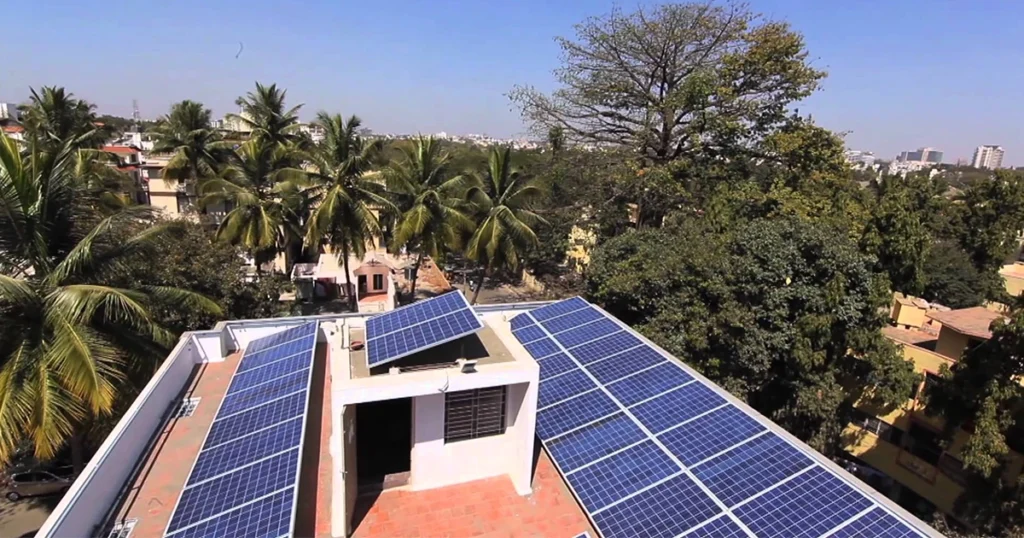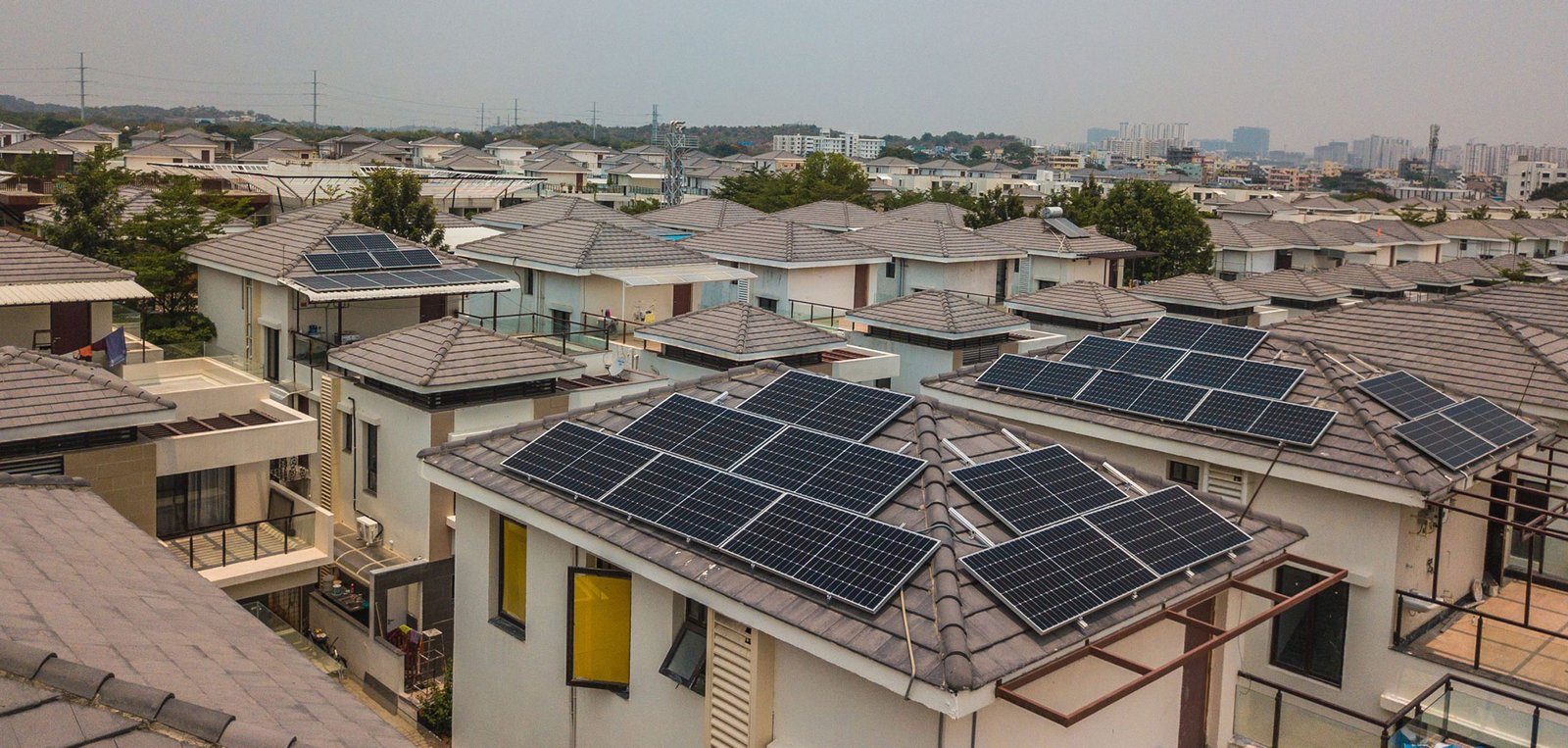A Complete Guide to 100% Solar Homes in 2025
Running a home fully on solar power is no longer a dream. It is happening in many Indian cities and towns. With the right system design, smart planning, and government support, you can meet all your household energy needs from the sun. But to answer this question in detail, we need to look at energy use, system size, batteries, costs, subsidies, and how solar works in Indian conditions.
The Simple Answer

Yes, you can run a home completely on solar. Thousands of Indian households already meet 100% of their annual electricity needs with rooftop solar and net metering. Some even stay independent during power cuts with hybrid systems and batteries. The key is choosing the right solar capacity, inverter type, and battery backup according to your lifestyle and budget.
Step 1: Understand Your Electricity Use
Your starting point is your monthly electricity bill. Collect at least 12 months. Check the total kWh (units) consumed each month. Also note peak loads like ACs, water pumps, geysers, induction stoves, and refrigerators.
- Small households: 150–300 units per month
- Medium households: 300–600 units per month
- Large households: 600–1000+ units per month
In summer, consumption rises due to fans and air conditioners. In monsoon, solar output drops due to clouds and rain. A proper calculation of average daily usage helps you size the right solar plant.
Also Read Offsetting Your Carbon Footprint with Solar Energy: A Complete Guide for Indian Homes and Businesses
Step 2: How Much Power Can Solar Panels Generate in India?
A thumb rule: 1 kW of rooftop solar produces 3–4.5 units per day on average. That equals 1,200–1,600 units per year, depending on location, sunlight hours, panel tilt, shading, and cleaning.
- Delhi: ~4 units per kW per day
- Mumbai: ~3.5 units per kW per day
- Bengaluru: ~4.2 units per kW per day
- Jaipur: ~4.5 units per kW per day
So, if your home uses 500 units per month, you may need a 4–5 kW solar system.
Step 3: How Much Roof Space Do You Need?
On average, 1 kW of solar requires 100 sq ft of shadow-free roof space.
- 3 kW system: ~300 sq ft
- 5 kW system: ~500 sq ft
- 10 kW system: ~1000 sq ft
Most urban Indian homes with flat RCC roofs have enough space for 3–5 kW systems. Villas or independent houses with bigger terraces can go higher.
Step 4: Choosing Between On-Grid, Off-Grid, and Hybrid Systems
On-grid solar (net metering):
- Connected to the electricity grid.
- Cheapest option, no batteries.
- You export extra power by day and import at night.
- Perfect for city homes where grid power is reliable.
Off-grid solar:
- Not connected to the grid.
- Needs large batteries for night use.
- Costliest option.
- Best for remote villages with no electricity supply.
Hybrid solar:
- Works with grid + solar + battery.
- Powers home during grid failure.
- Gives peace of mind in areas with frequent power cuts.
- Costlier than pure on-grid but more practical for Indian cities.
Step 5: Day vs Night – How a 100% Solar Home Actually Works
Daytime:
- Solar panels run most of your appliances.
- Surplus is exported to the grid (if on-grid).
- Heavy appliances like washing machines, water heaters, and even EV charging should be scheduled in the day.
Nighttime:
- You either import electricity from the grid using credits from daytime exports.
- Or, if you have batteries, you run your home from stored solar power.
Thus, a 100% solar-powered home in India usually means your annual net electricity use is zero.
Step 6: Sizing the Right System
Example for a medium Indian home:
- Daily use: 12–15 kWh
- Solar needed: 5 kW (generates ~20 kWh per day on average)
- Hybrid inverter: 5–6 kVA
- Battery (optional): 5–10 kWh for evening backup
With this setup, most of your energy is met by solar. At night, you either use battery power or rely on net metering.
Step 7: Cost of Running a Home on Solar in 2025
Costs vary by brand and state, but here are typical estimates:
- On-grid rooftop solar: ₹45,000–₹60,000 per kW (before subsidy)
- Hybrid inverter premium: ₹30,000–₹60,000 extra
- Lithium battery (5 kWh): ~₹1.1 lakh
- Lithium battery (10 kWh): ~₹2.2 lakh
Government Subsidy (PM Surya Ghar: Muft Bijli Yojana):
- 1 kW: ₹30,000 subsidy
- 2 kW: ₹60,000 subsidy
- 3 kW or more: ₹78,000 maximum subsidy
Example Budget for 5 kW Hybrid System (2025):
- Hardware + installation: ~₹2.5–3 lakh
- Subsidy: up to ₹78,000
- Battery (optional): ₹1.1–2.2 lakh extra
Step 8: Can Solar Run ACs and Heavy Appliances?
Yes, but sizing is important.
- A 1.5-ton inverter AC consumes 1.0–1.6 kW while running.
- To run multiple ACs at once, you need at least 5–8 kW solar.
- ACs at night require batteries or grid support.
Smart Tip: Pre-cool your home in the afternoon when solar generation is high. Use ceiling fans to keep rooms cooler for longer.
Step 9: Solar During Power Cuts
If you live in areas with frequent load shedding, a hybrid solar system is the best choice. It will:
- Use solar power in the day.
- Charge batteries for night use.
- Run essential loads like lights, fans, Wi-Fi, and fridge during outages.
This reduces your dependence on diesel generators or inverters.
Step 10: Net Metering for True 100% Solar
Net metering allows you to offset day exports with night imports. Your yearly bill can become close to zero. The rules vary by state, but the national cap is up to 500 kW for residential consumers.
This means if your home produces the same annual energy it consumes, you are officially running 100% on solar.
Advantages of a 100% Solar-Powered Home
- Lower bills: Save 80–100% on electricity bills.
- Energy independence: Protection from tariff hikes.
- Backup: Hybrid systems keep essentials running during outages.
- Environment-friendly: Zero carbon electricity.
- Property value: Solar-ready homes attract buyers.
Challenges to Consider
- High upfront cost (even after subsidy).
- Battery costs are still significant.
- Roof size and shading may limit system size.
- Maintenance: Panels need cleaning, especially in dusty cities.
- Policy delays: Net metering approvals sometimes take time.
FAQs on Running a Home Fully on Solar
Q1. Can a normal Indian home run only on solar without grid support?
Yes, with a large solar system and batteries. But most homes prefer hybrid or on-grid for reliability.
Q2. How long do solar panels last?
Good quality panels last 25 years or more. Inverters last 7–12 years. Batteries last 6–10 years.
Q3. How much money can I save?
Savings depend on usage and tariff. A 5 kW system can save ₹7,000–₹10,000 per month in big cities.
Q4. What if my roof is small?
You can install smaller systems for partial savings. In some states, community or group housing solar is an option.
Q5. Can solar run a water pump?
Yes, solar can run submersible pumps. Many farmers in India already use solar pump sets.
Q6. Can I run an EV on solar?
Yes. A 2–3 kW extra system is enough to charge an electric scooter or small EV daily.
Final Word
So, can you run a home completely on solar in India? The answer is Yes. With the right solar rooftop system, hybrid inverter, and battery storage, your home can achieve 100% solar power. Thanks to government subsidies, falling solar panel prices, and rising electricity tariffs, the financial case has never been stronger.
For most Indian households in 2025, a 5 kW hybrid solar system with net metering is the sweet spot. It cuts bills close to zero, provides backup in power cuts, and pays back in 5–7 years. Beyond that, you enjoy almost free and clean power from the sun for decades.










